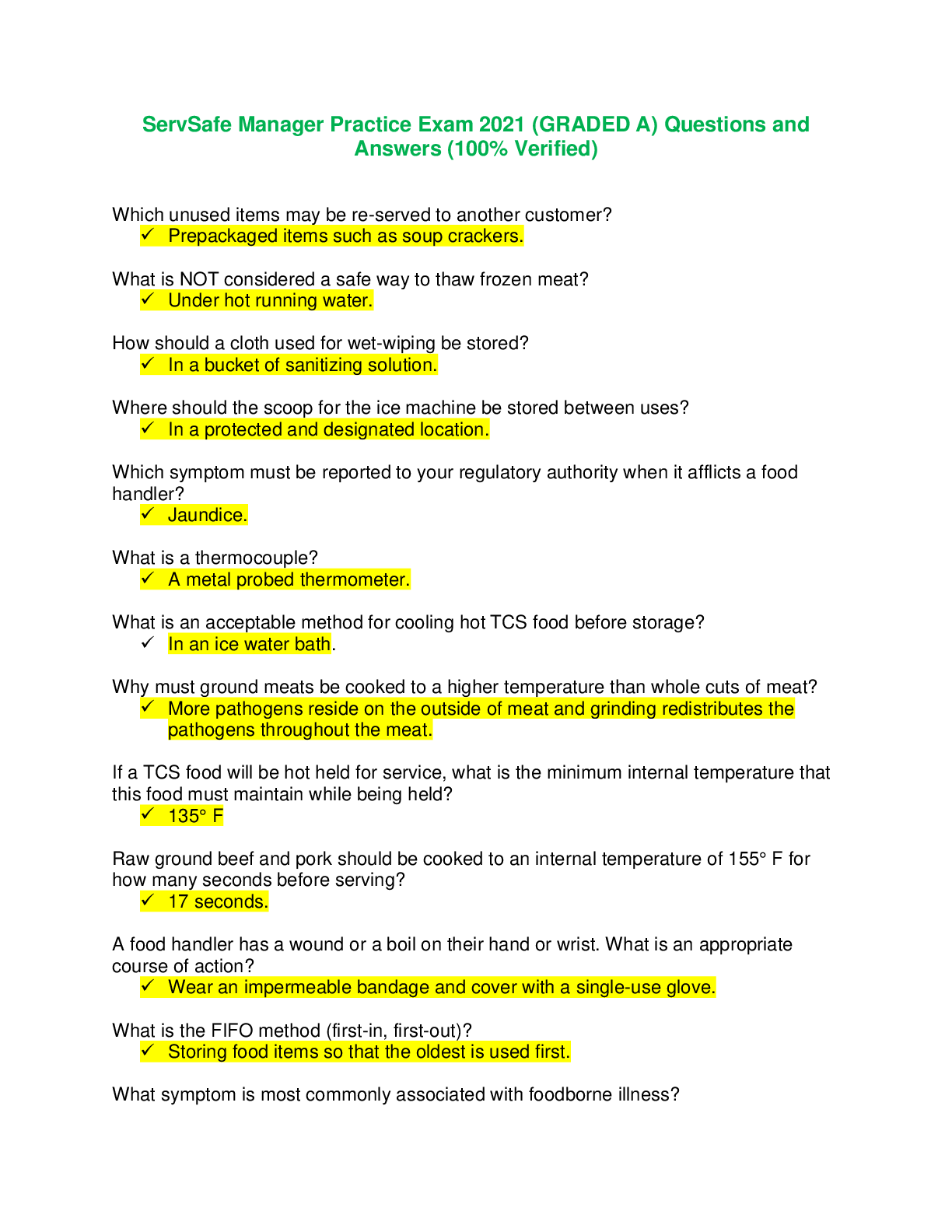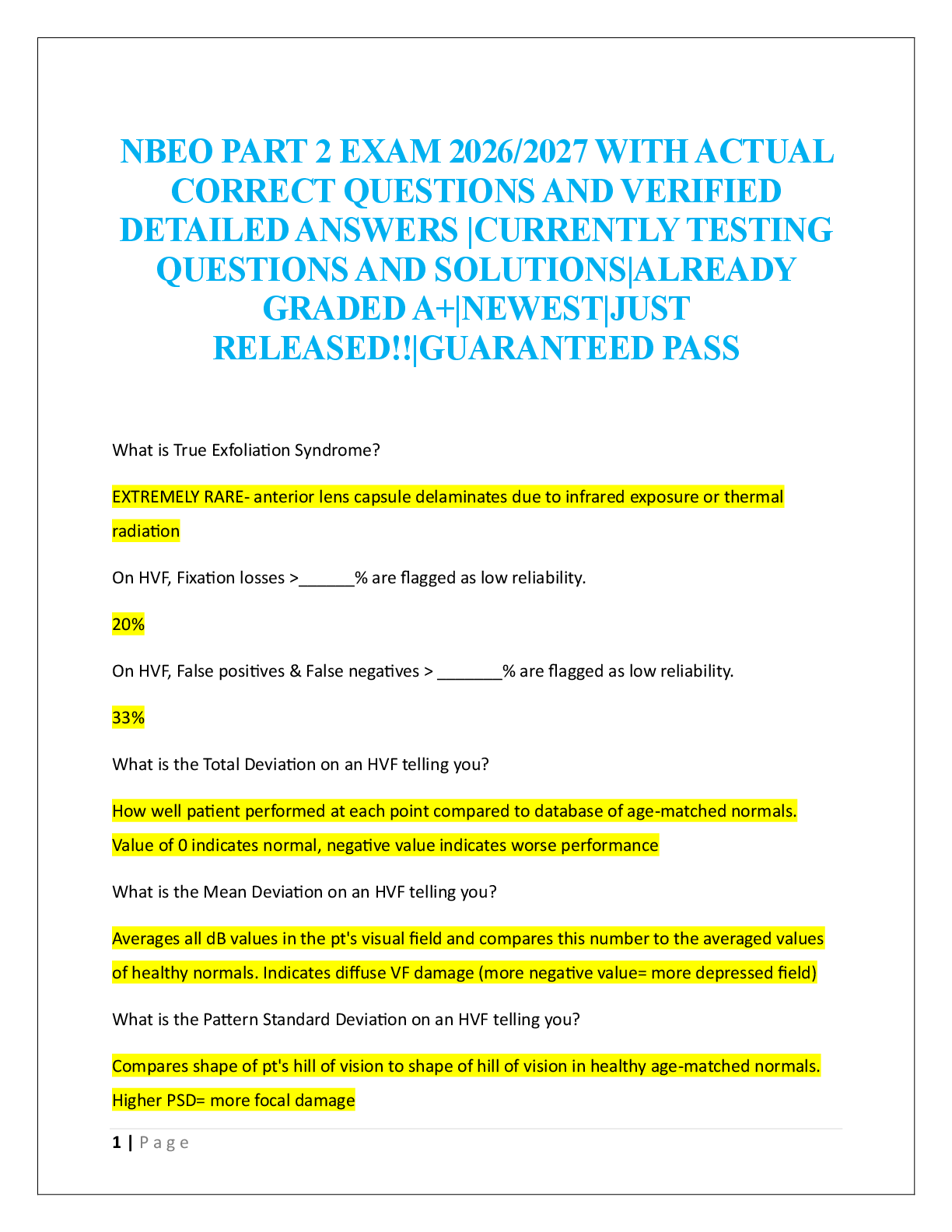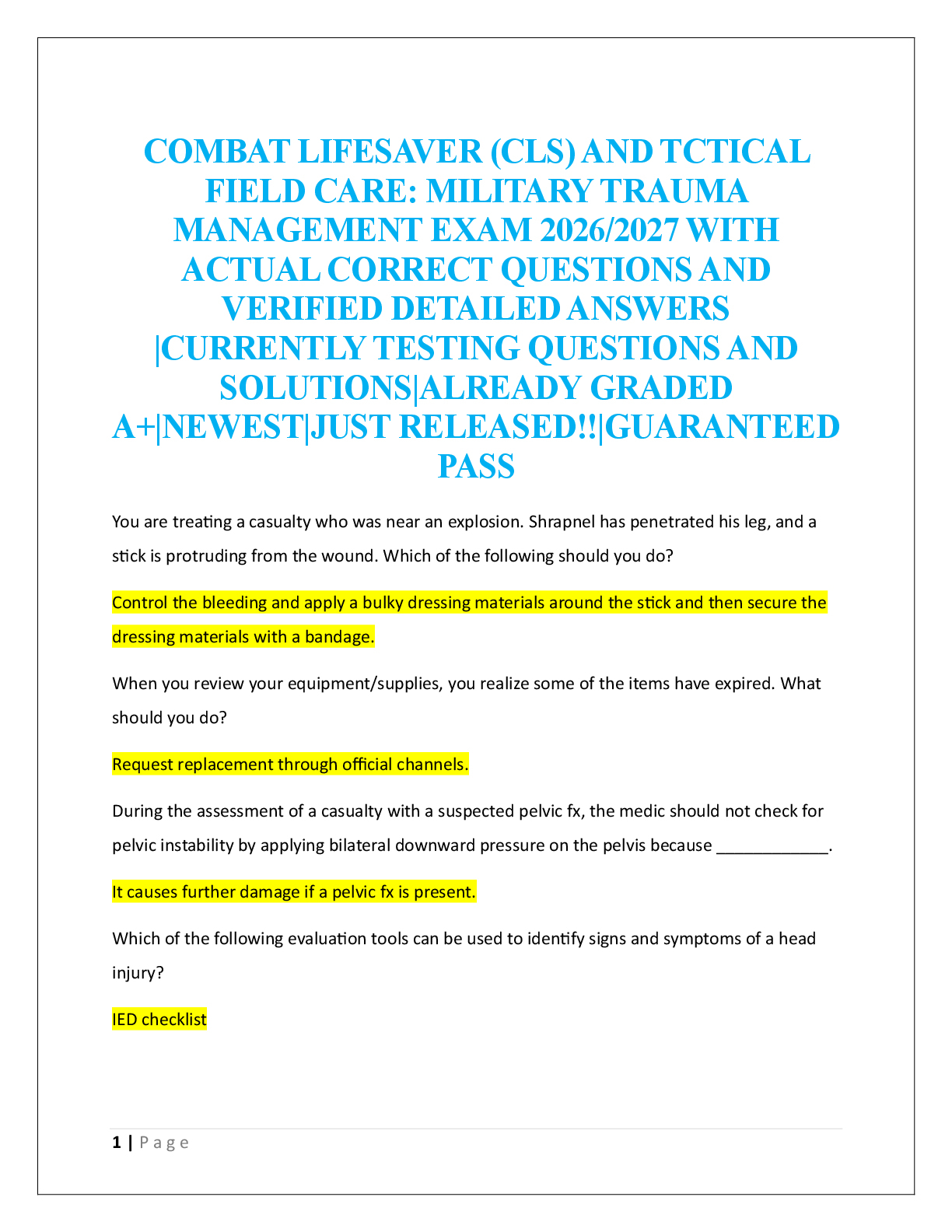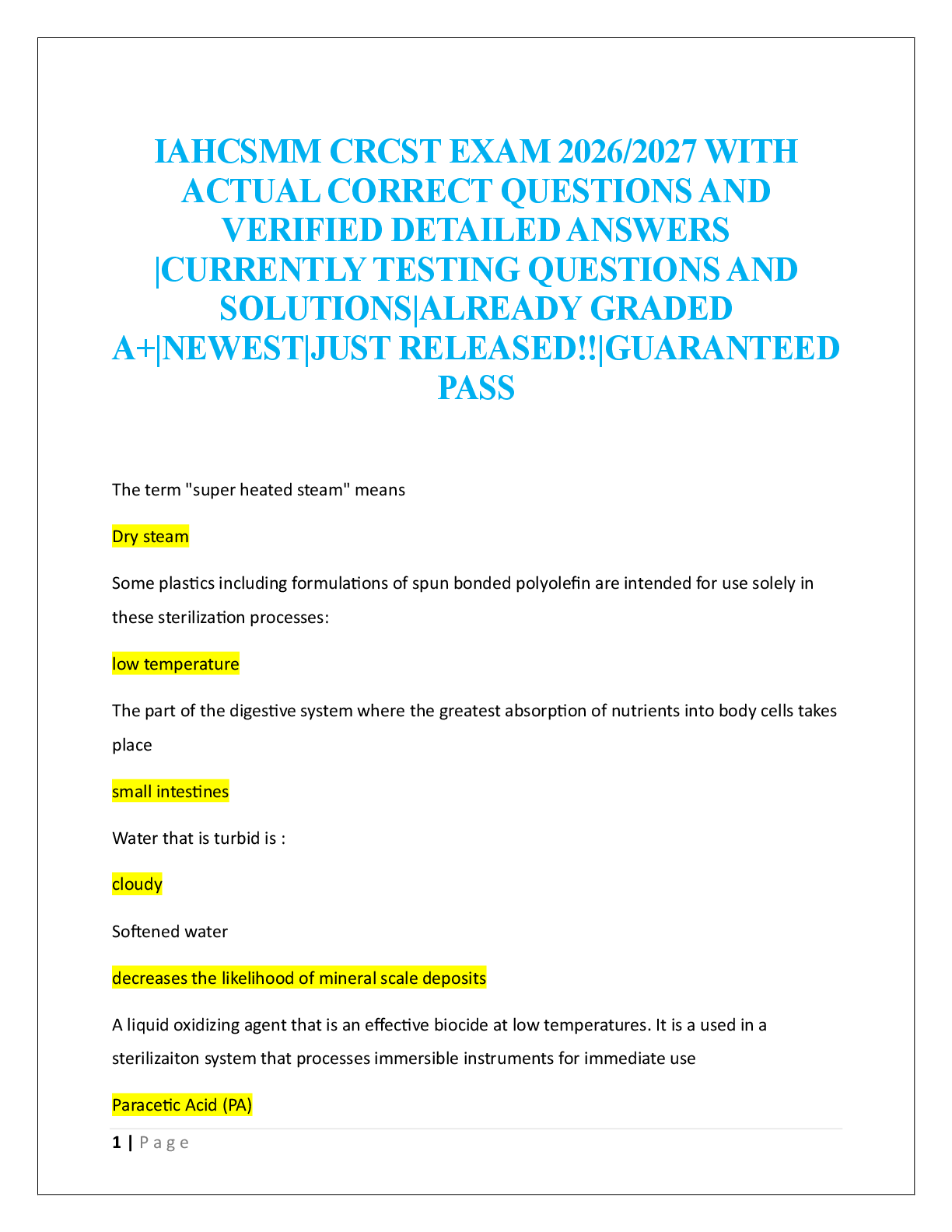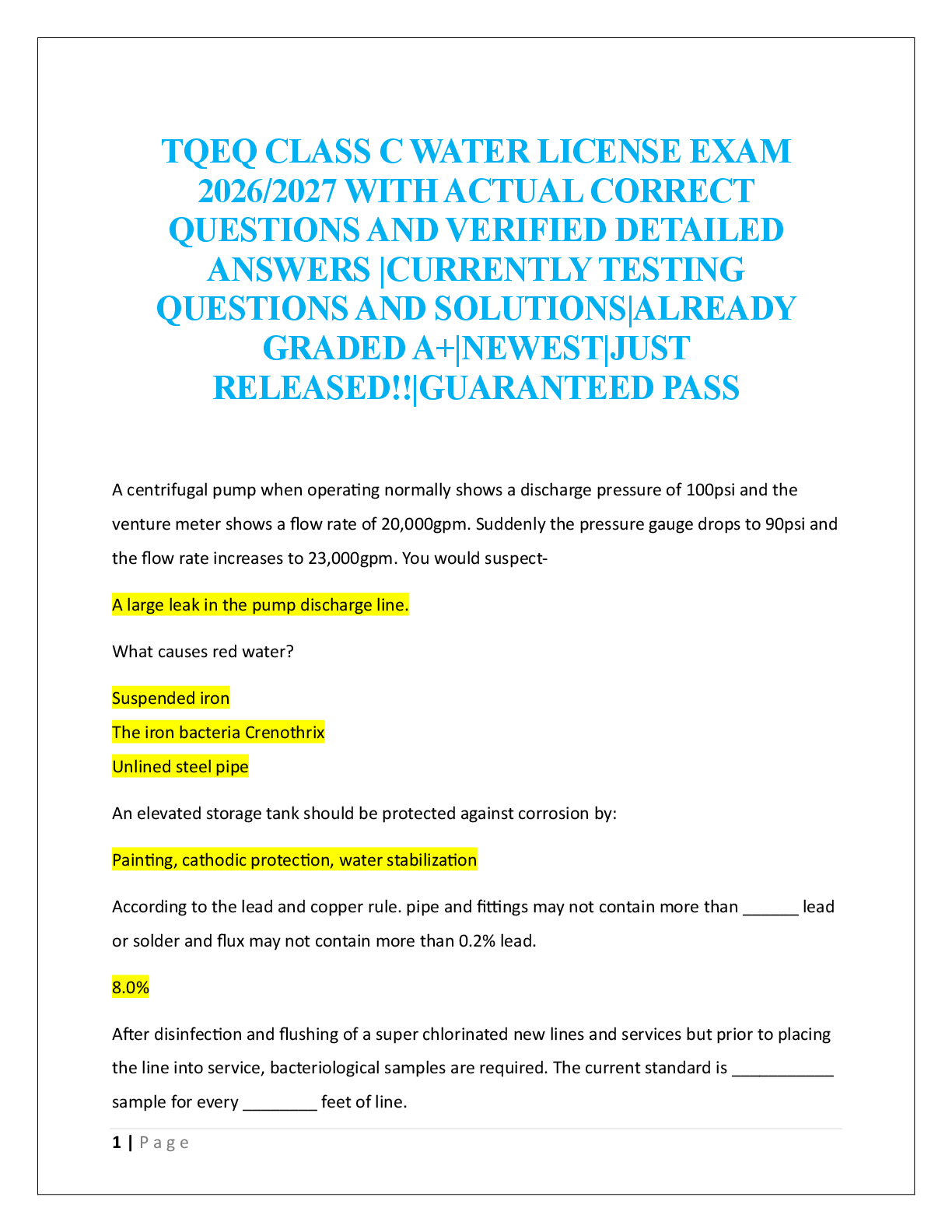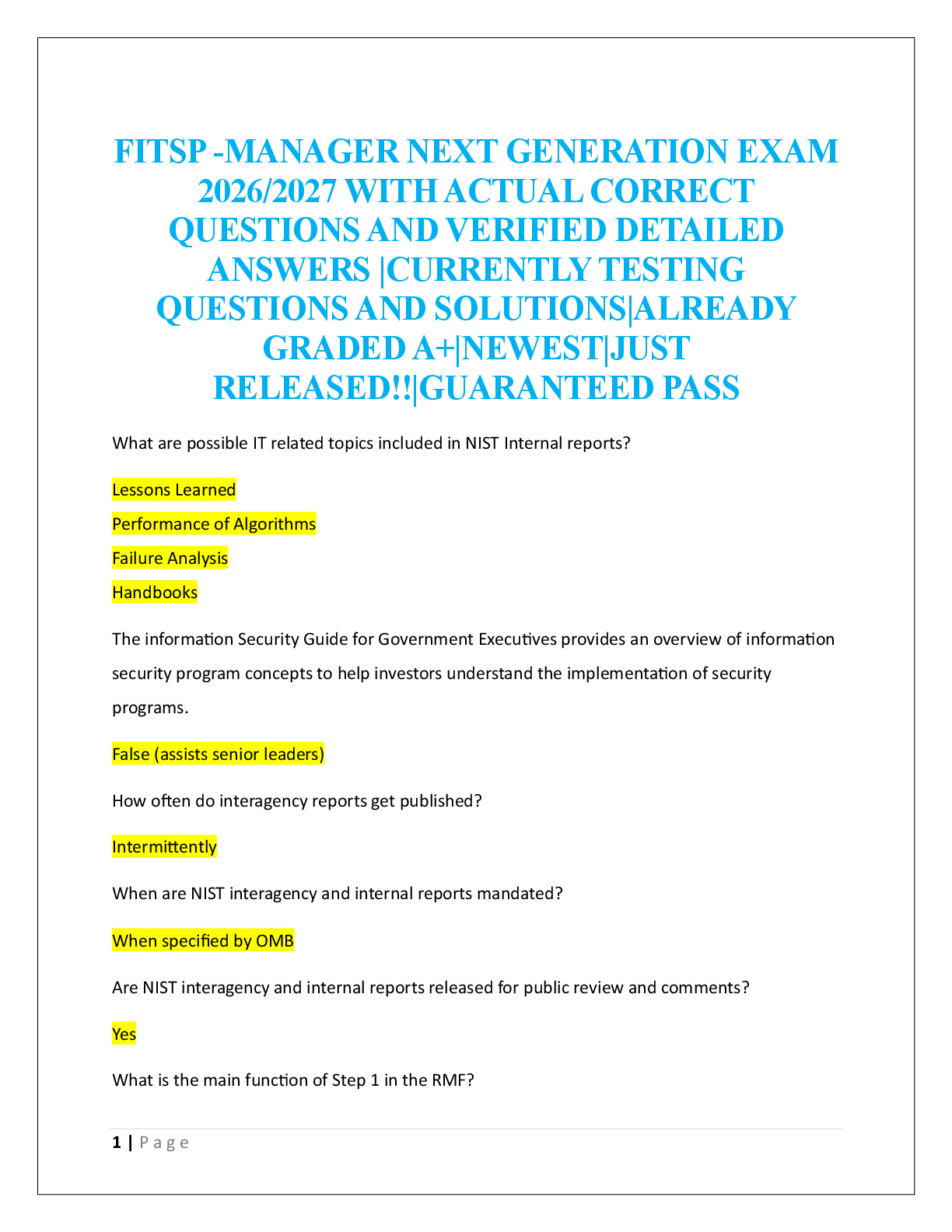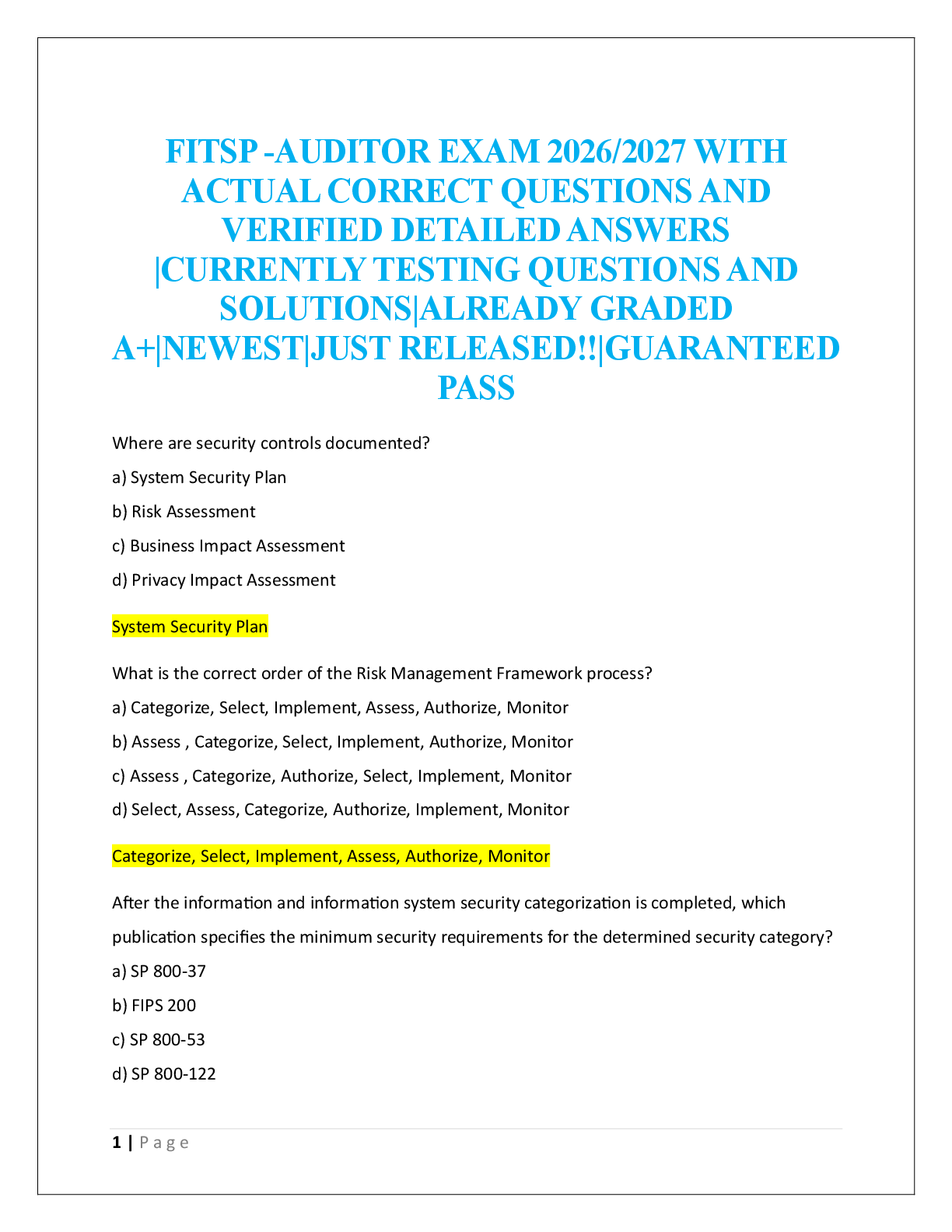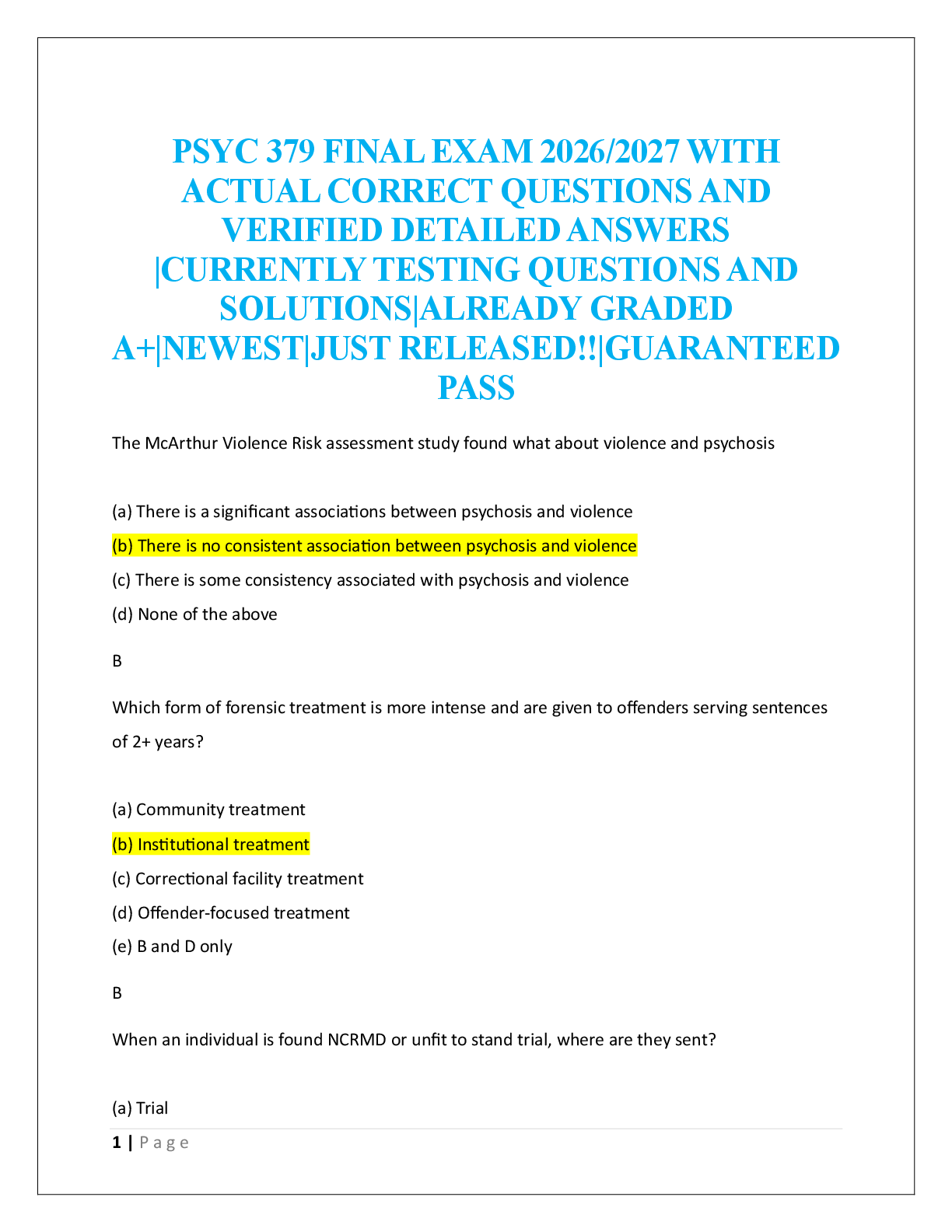Health Care > EXAM > HSM 543 Week 2 Quiz (GRADED A) Questions and Answers | 100% guaranteed (All)
HSM 543 Week 2 Quiz (GRADED A) Questions and Answers | 100% guaranteed
Document Content and Description Below
HSM 543 Week 2 Quiz The difference between operating margin and total margin is which of the following? Operating margin does not indicate profitability from ongoing operations. Operati ... ng margin is operating income ÷ total operating revenue. Total margin is gross profit ÷ total revenue. One is a profitability ratio and the other is an efficiency ratio. Neither ratio is used by management or external users of financial statements. Both are operating indicators. CO D) The balance sheet includes three main categories. Give examples of each of the three categories. (Hint: Remember the accounting equation.) The balance sheet presents the organization's assets, liabilities, and net assets. Assets = Liabilities + Net Assets Assets All assets should be divided into current and noncurrent assets. An asset is considered current if it can reasonably be converted into cash within one year. Cash, inventories and net receivables are all important current assets because they offer flexibility and solvency. Cash is the headliner. Companies that generate a lot of cash are often doing a good job satisfying customers and getting paid. While too much cash can be worrisome, too little can raise a lot of red flags. Liabilities Like assets, liabilities are either current or noncurrent. Current liabilities are obligations due within a year. Fundamental investors look for companies with fewer liabilities than assets, particularly when compared against cash flow. Companies that owe more money than they bring in are usually in trouble. Equity Equity is equal to assets minus liabilities, and it represents how much the company's shareholders actually have claim to; investors should pay particular attention to retained earnings and paid-in capital under the equity section. Paid-in capital represents the initial investment amount paid by shareholders for their ownership interest. Compare this to additional paid-in capital to show the equity premium investors paid above par value. Retained earnings show the amount of profit the firm reinvested or used to pay down debt, rather than distributed to shareholders as dividends. Read more: What items on the balance sheet are most important in fundamental analysis? | Investopedia https://www.investopedia.com/ask/answers/050615/what- items-balance-sheet-are-most-important-fundamental-analysis.asp#ixzz5WColW6Tq Follow us: Investopedia on Facebook (CO D) Discuss the role of explanatory notes. According to Maire Loghran explanatory notes are discussions of items that accompany the financial statements, which are the income statement, the balance sheet, and the statement of cash flows. These notes are important disclosures that further explain numbers on the financial statements. The reason for these notes harkens back to fulfilling the needs of the external users of the financial statements. https://www.dummies.com/business/accounting/ten-common-notes-to-the-financial-statements/ Explanatory notes for the balance sheet and the other financial statements should identify extraordinary events, as well as certain required provisions, and should be presented following the financial statements. In fiscal years beginning after December 15, 2018, public organizations and not-for- profit organizations that have issued securities that are traded or listed on an exchange or over-the- counter market will be expected to present the effects of all leases on the balance sheet (the deadline for all other organizations is fiscal years beginning after December 15, 2019). ASU 2016-02, Leases (Topic 842) intends to increase transparency and comparability among organizations by requiring all organizations, not just healthcare organizations, to present the effects of both financial leases and operating leases on the balance sheet (historically, organizations have not presented the effects of operating leases on the balance sheet). The organization should recognize a liability (lease payments) and a right-of-use asset on the balance sheet (Connor and Mosrie 2016). Explanatory notes identify extraordinary events, as well as certain required provisions, and should be presented following the financial statements. (CO D) What is included in permanently restricted net assets? Permanently restricted net assets include donor-restricted net assets with restrictions that never expire, such as endowment funds. In fiscal years beginning after December 15, 2017, organizations will be expected to present net assets in two categories instead of three: “net assets without donor restrictions” and “net assets with donor restrictions.” Generally accepted accounting principles (GAAP) will require organizations to disclose the amount, purpose, and type of board restrictions for net assets without donor restrictions, and GAAP will require organizations to disclose the nature and amount of donor restrictions for net assets with donor restrictions (Connor and Mosrie 2016). (CO D) The difference between operating margin and total margin is which of the following? 21172 Operating margin does not indicate profitability from ongoing operations. Correct! 98662 Operating margin is operating income ÷ total operating revenue. Total margin is gross profit ÷ total revenue. 17133 One is a profitability ratio and the other is an efficiency ratio. 55320 Neither ratio is used by management or external users of financial statements. 94307 Both are operating indicators. See Nowicki, page 306. Move To... Question 2 5 / 5 pts (CO D) The balance sheet includes three main categories. Give examples of each of the three categories. (Hint: Remember the accounting equation.) Your Answer: The balance sheet presents the organization's assets, liabilities, and net assets. Assets = Liabilities + Net Assets Assets All assets should be divided into current and noncurrent assets (Links to an external site.)Links to an external site.. An asset is considered current if it can reasonably be converted into cash within one year. Cash, inventories and net receivables are all important current assets (Links to an external site.)Links to an external site. because they offer flexibility and solvency (Links to an external site.)Links to an external site.. Cash is the headliner. Companies that generate a lot of cash are often doing a good job satisfying customers and getting paid. While too much cash can be worrisome, too little can raise a lot of red flags. Liabilities Like assets, liabilities are either current or noncurrent. Current liabilities (Links to an external site.)Links to an external site. are obligations due within a year. Fundamental investors look for companies with fewer liabilities than assets, particularly when compared against cash flow (Links to an external site.)Links to an external site.. Companies that owe more money than they bring in are usually in trouble. Equity Equity is equal to assets minus liabilities, and it represents how much the company's shareholders actually have claim to; investors should pay particular attention to retained earnings (Links to an external site.)Links to an external site. and paid-in capital under the equity section. Paid-in capital represents the initial investment amount paid by shareholders for their ownership interest. Compare this to additional paid-in capital (Links to an external site.)Links to an external site. to show the equity premium investors paid above par (Links to an external site.)Links to an external site. value. Retained earnings show the amount of profit the firm reinvested or used to pay down debt, rather than distributed to shareholders as dividends. Read more: What items on the balance sheet are most important in fundamental analysis? | Investopedia (Links to an external site.)Links to an external site. https://www.investopedia.com/ask/answers/050615/what-items-balance-sheet-are-most- important-fundamental-analysis.asp#ixzz5WColW6Tq (Links to an external site.)Links to an external site. Follow us: Investopedia on Facebook (Links to an external site.)Links to an external site. See Nowicki, pages 296–297. The three categories are assets, liabilities, and owners equity. Move To... Question 3 5 / 5 pts (CO D) Discuss the role of explanatory notes. Your Answer: According to Maire Loghran explanatory notes are discussions of items that accompany the financial statements, which are the income statement, the balance sheet, and the statement of cash flows. These notes are important disclosures that further explain numbers on the financial statements. The reason for these notes harkens back to fulfilling the needs of the external users of the financial statements. https://www.dummies.com/business/accounting/ten-common-notes-to-the-financial- statements/ Explanatory notes for the balance sheet and the other financial statements should identify extraordinary events, as well as certain required provisions, and should be presented following the financial statements. In fiscal years beginning after December 15, 2018, public organizations and not-for-profit organizations that have issued securities that are traded or listed on an exchange or over-the-counter market will be expected to present the effects of all leases on the balance sheet (the deadline for all other organizations is fiscal years beginning after December 15, 2019). ASU 2016-02, Leases (Topic 842) intends to increase transparency and comparability among organizations by requiring all organizations, not just healthcare organizations, to present the effects of both financial leases and operating leases on the balance sheet (historically, organizations have not presented the effects of operating leases on the balance sheet). The organization should recognize a liability (lease payments) and a right-of-use asset on the balance sheet (Connor and Mosrie 2016). See Nowicki, page 298. Explanatory notes identify extraordinary events, as well as certain required provisions, and should be presented following the financial statements. Move To... Question 4 5 / 5 pts (CO D) What is included in permanently restricted net assets? Your Answer: According to the book Permanently restricted net assets (Links to an external site.)Links to an external site. include donor-restricted net assets with restrictions that never expire, such as endowment funds. In fiscal years beginning after December 15, 2017, organizations will be expected to present net assets in two categories instead of three: “net assets without donor restrictions” and “net assets with donor restrictions.” Generally accepted accounting principles (GAAP) will require organizations to disclose the amount, purpose, and type of board restrictions for net assets without donor restrictions, and GAAP will require organizations to disclose the nature and amount of donor restrictions for net assets with donor restrictions (Connor and Mosrie 2016). See Nowicki, page 298. Donor-restricted net assets with restrictions that never expire, such as endowment funds, are included. (CO D) Which one of the following is not a capital structure ratio? Current asset turnover [Show More]
Last updated: 3 years ago
Preview 1 out of 7 pages

Buy this document to get the full access instantly
Instant Download Access after purchase
Buy NowInstant download
We Accept:

Also available in bundle (1)
Click Below to Access Bundle(s)

HSM 543 Weekly Quizzes Week 1 – 3, 5 – 6 (Collection)
HSM 543 Week 1 Quiz – Questions/Answer HSM-543 Week 2 Quiz – Questions/Answer HSM 543 Week 3 Quiz – Questions/Answer HSM-543 Week 5 Quiz – Questions/Answer HSM 543 Week 6 Quiz – Questions/...
By Prof. Goodluck 3 years ago
$13.5
11
Reviews( 0 )
$12.00
Can't find what you want? Try our AI powered Search
Document information
Connected school, study & course
About the document
Uploaded On
Sep 27, 2022
Number of pages
7
Written in
All
Additional information
This document has been written for:
Uploaded
Sep 27, 2022
Downloads
0
Views
121


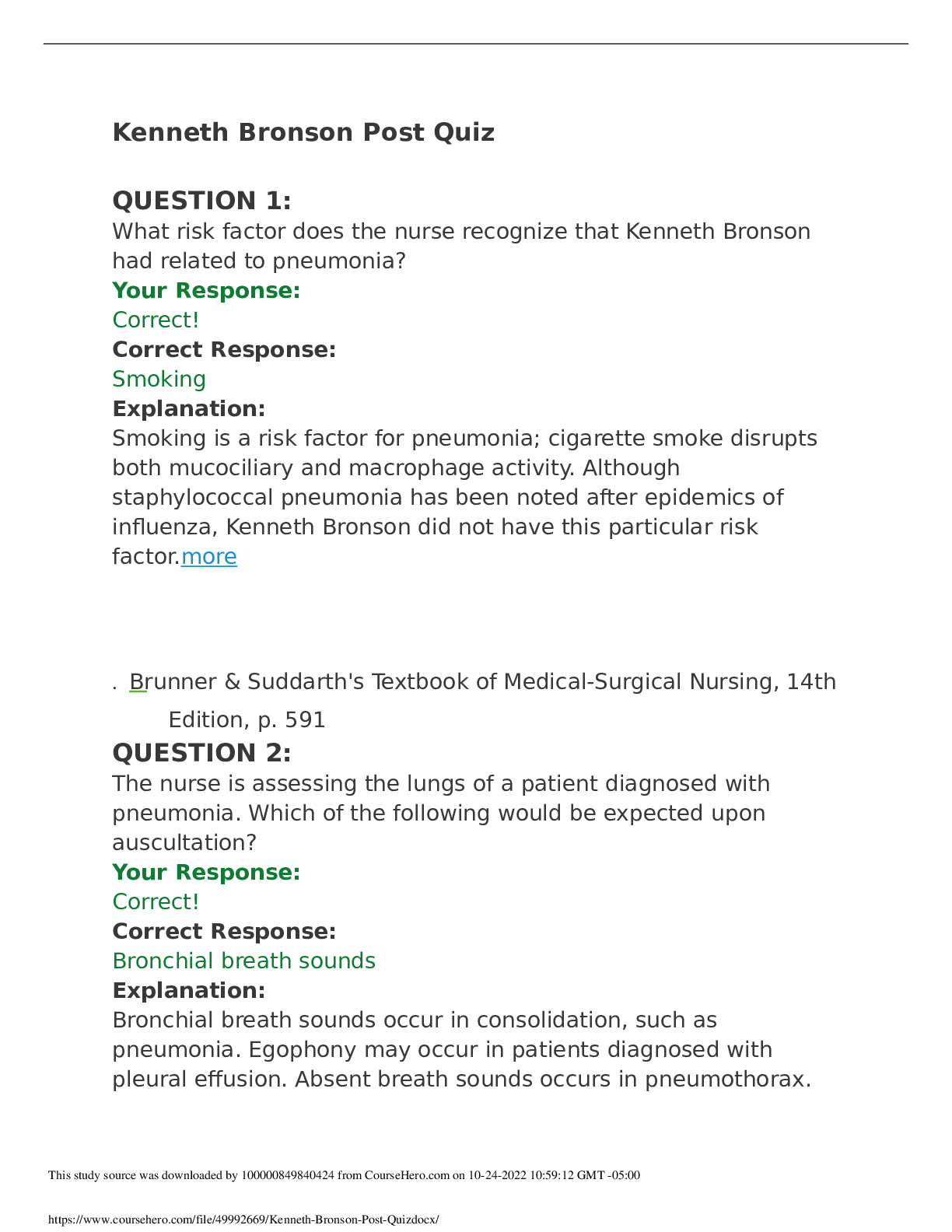



 Questions and Answers 100% VERIFIED.png)
 Questions and Answers 100% correct Solutions.png)



